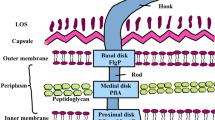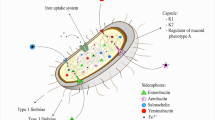Abstract
The morphologic conversion ofHelicobacter pylori from bacillary to coccoid form was studied by microscopy, viable count on agar plates, and bioluminescence assay of bacterial ATP. When morphologic conversion from bacillary to coccoid form was detected by microscopy, the viable counts and the bacterial ATP decreased. No viable count was found after nine days of incubation, but bacterial ATP was still present. In these cultures in which only the coccoid form ofHelicobacter pylori was present, there was no accumulation of extracellular ATP, indicating no leaky cells. During the transition phase from the bacillary to the coccoid form ofHelicobacter pylori, the addition of fresh medium increased the intracellular ATP 26-fold. The coccoid form ofHelicobacter pylori had a 1000-fold lower ATP level per cell compared to the bacillary form, which indicates a decreased metabolic activity in the coccoid form. Addition of fresh medium to the coccoid cultures from days 9 and 10 increased the ATP level twofold. However, no conversion from coccoid to bacillary form was found in these cultures during prolonged incubation in fresh broth for four weeks. Such conversion needs to be demonstrated before it is proven that the coccoid form ofHelicobacter pylori is responsible for transmission and relapse of infection.
Similar content being viewed by others
References
Warren JR, Marshall B: Unidentified curved bacilli on gastric epithelium in active chronic gastritis. Lancet 1983, i: 1273–1275.
Marshall BJ, Warren JR: Unidentified curved bacilli in the stomach of patients with gastritis and peptic ulceration. Lancet 1984, i: 1311–1314.
Goodwin CS, Armstrong JA, Marshall BJ:Campylobacter pyloridis, gastritis, and peptic ulceration. Journal of Clinical Pathology 1986, 39: 353–365.
West AR Millar MR, Tompkins DS: Survival ofHelicobacter pylori in water and saline. Journal of Clinical Pathology 1990, 43: 609.
Bode G, Mauch F, Malfertheiner P: The coccoid form ofHelicobacter pylori. Criteria for their viability. Epidemiology and Infection 1993, 111: 483–490.
Nilius M, Ströhle A, Bode G, Malfertheiner P: Coccoid like form (CLF) ofHelicobacter pylori. Enzyme activity and antigenicity. Zentralblatt für Bakteriologie 1993, 280: 259–272.
Cellini L, Allocati N, Di Campli E, Dainelli B:Helicobacter pylori: a fickle germ. Microbiology and Immunology 1994, 38: 25–30.
Catrenich CE, Makin KM: Characterization of the morphologic conversion ofHelicobacter pylori bacillary to coccoid form. Scandinavian Journal of Gastroenterology 1991, 26, Supplement 181: 58–64.
Mai U, Geis G, Leying H, Ruhl G, Opferkuch W: Dimorphism ofCampylobacter pylori. In: Megraud F, Lamoulaitte H (ed): Gastroduodenal pathology andCampylobacter pylori. Elsevier, Amsterdam, 1989, p. 29–33.
Moshkowitz M, Gorea A, Arber N, Konikoff F, Berger S, Gilat T: Morphological transformation ofHelicobacter pylori during prolonged incubation. Association with decreased acid resistance. Journal of Clinical Pathology 1994, 47: 172–174.
Jones DM, Currey A: The genesis of coccal form ofHelicobacter pylori. In: Malfertheiner P, Ditschuneit H (ed):Helicobacter pylori, gastritis and peptic ulcer. Springer-Verlag, Berlin, 1990, p. 29–37.
Eaton KA, Catrenich CE, Makin KM: Virulence of coccoid and bacillary forms ofHelicobacter pylori in gnotobiotic piglets. Journal of Infectious Diseases 1995, 171: 459–462.
Ng L-K, Sherburne R, Taylor DE, Stiles ME: Morphological form and viability ofCampylobacter species studied by electron microscopy. Journal of Bacteriology 1985, 164: 338–343.
Samir SK, Setarrunnahar S, Suhas SC: Recovery of injuredCampylobacter jejuni cells after animal passage. Applied and Environmental Microbiology 1991, 57: 3388–3389.
Beumer RR, de Vries J, Rombouts FM:Campylobacter jejuni non-culturable coccoid cells. International Journal of Food Microbiology 1992, 15: 153–163.
Amano K, Shibata Y: Structural studies of peptidoglycans inCampylobacter species. Microbiology and Immunology 1992, 36: 961–967.
Moran AR Upton ME: A comparative study of the rod and coccoid form ofCampylobacter jejuni ATCC 29428. Journal of Applied Bacteriology 1986, 60: 103–110.
Chan W-Y, Hui P-K, Leung K-M, Chow J, Kwoki F, Ng C-S: Coccoid forms ofHelicobacter pylori in the human stomach. American Journal of Clinical Pathology 1994, 102: 503–507.
Cellini L, Allocati N, Angelucci D, Lezzi T, Di Campli E, Marzio L, Dainelli B: CoccoidHelicobacter pylori not culturable in vitro reverts in mice. Microbiology and Immunology 1994, 38: 843–850.
Jones DM, Sutcliffe EM, Curry A: Recovery of viable but not-culturableCampylobacter jejuni. Journal of General Microbiology 1991, 137: 2477–2482.
Buck GE, Parshall KA, Davis CP: Electron microscopy of the coccoid form ofCampylobacter jejuni. Journal of Clinical Microbiology 1983, 18: 420–421.
Moran AR Upton ME: Factors affecting production of coccoid forms byCampylobacter jejuni on solid media during incubation. Journal of Applied Bacteriology 1987, 62: 527–537.
Merell BR, Walker RI, Coolbaugh JC:Campylobacter fetus, ssp.jejuni, a newly recognised enteric pathogen: morphology and intestinal colonization. Scanning Electron Microscopy 1981, 41: 125–131.
Author information
Authors and Affiliations
Rights and permissions
About this article
Cite this article
Sörberg, M., Nilsson, M., Hanberger, H. et al. Morphologic conversion ofHelicobacter pylori from bacillary to coccoid form. Eur. J. Clin. Microbiol. Infect. Dis. 15, 216–219 (1996). https://doi.org/10.1007/BF01591357
Issue Date:
DOI: https://doi.org/10.1007/BF01591357




